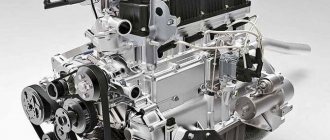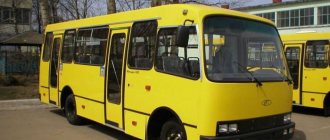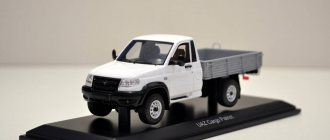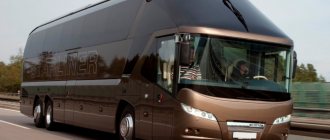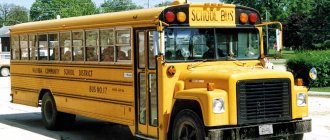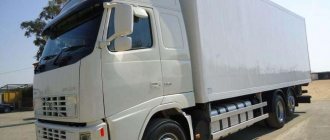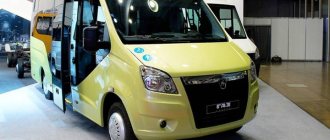Bogdan-A092 The middle class bus Bogdan A092 has been produced in Ukraine since February 11, 2003 by the Bogdan Corporation. These buses, built on the chassis and components of Japanese Isuzu buses, are also used in Russia, Belarus and Georgia. The car has a lower floor level and two doors. The declared service life of the Japanese Isuzu engine is 1 million kilometers before major overhaul. In addition to the engine, the gearbox, driveshaft, front and rear axles are also Japanese, and the pneumatics are made in Italy.
Fiberglass was used in the structure of the bus body.
Bogdan-A092 could be either suburban (27 seats) or urban (21 seats). Two engines were available, both turbodiesels: 4.6 l, 121 hp. Euro-2 or 4.8 l, 145 hp, Euro-3. The braking system includes ABS and brake force regulator.
In 2010, Bogdan A093 appeared, which had an increased length.
Since 2011, the production of buses in Ukraine ceased and began at Cherkasy Bus JSC. The appearance has undergone minor changes. Since 2012, versions that had a new frontal and rear masks were called Ataman A092.
Bus Bogdan: description, technical characteristics, modifications, photos.
kammikadze
February 10, 2012 1:05 pm
Standard equipment in the “suburban” modification: front door with pneumatic drive, rear (emergency) mechanical door, soft folding seats with armrests, technical upholstery, shelves in the cabin for small luggage, one emergency ventilation hatch, luggage compartment (~2 m3 ), four speakers and preparation for a radio, the body is painted white.
- Video
- Photo
- New items
- With your own hands
- Specifications
- Prices
External features of the Bogdan bus series
The outer part is made of fiberglass, rolled and galvanized steel. The main purpose of this part is safety and design.
The rear and side windows are made of tempered glass. Three-layer anti-reflective glass with a rubber profile of the “Triplex” type is inserted into the wind window. Due to the matte surface, the risk of blinding the driver is completely eliminated.
Two hatches on the roof of the bus. Natural ventilation system - through hatches and sliding windows.
Increasing production capacity
In 2000, the company acquired the Lutsk Automobile Plant. From that moment on, the corporation began to actively invest, modernize and expand production. Already in 2003, buses began to be exported abroad. Four years later, the share of transport sold to other countries (CIS and neighboring countries) reached approximately 50% of the total volume.
The further history of the Bogdan brand is connected with the creation of an automobile corporation. In 2005, several Ukrainian automobile enterprises united in order to strengthen the capabilities of manufacturers to produce vehicles of all types. The corporation was named "Bogdan". Today it is a large association that includes 20 companies of various profiles. Among them are OJSC Cherkasy Bus, PJSC auto company Bogdan Motors, LLC Cherkastekhnomash and others.
Thanks to the merger of companies, the corporation took first place in Ukraine among bus manufacturers, and second place in terms of the number of cars. In the first 3 months of 2007, the company released about 700 buses to the market (40% more than in the past). Among other things, a tourist bus and a new trolleybus model with low floors were presented.
Models and modifications of the Hyundai bus "Bogdan" A201
Bogdan-A20110
– city bus, Hyundai D4DD engine (140 hp, Euro-3), 5-speed gearbox
Bogdan-A20111
– city bus, Hyundai D4GA engine (150 hp, Euro-4), 6-speed gearbox
Bogdan-A20210
– intercity bus, Hyundai D4DD engine (140 hp, Euro-3), 5-speed gearbox
Bogdan-A20211 - intercity bus, Hyundai D4GA engine (150 hp, Euro-4), 6-speed gearbox
Bogdan-A20410
– bus for transporting schoolchildren, Hyundai D4DD engine (140 hp, Euro-3), 5-speed gearbox
Bogdan A092
Admin/ December 1, 2017/
Details
Manufacturer: Bogdan
Category: Medium capacity
Years of production:
Bogdan A-092: 2003-2014
Bus A-092 is a modernized version of the A-091 model. The presentation date was February 11, 2003. In addition to restyling, it received a microprocessor control system for the power unit to comply with Euro-3 standards. Compared to its predecessor, the level of emission of toxic substances has decreased by 3-5 times.
The body lengthened somewhat (by 215 mm), and the braking system was supplemented by a traction control system. The rear and front masks, lighting equipment, seats in the cabin have changed, and the design of the doors for the driver and passengers has been redesigned.
Since 2003, Bogdan A-092 has been exported to Russia, Belarus and Georgia. Since 2005, large-unit assembly has been carried out from vehicle kits at the Belarusian enterprise Gomel Automobile Repair Plant. In Belarus, Bogdan A092 is produced under the name "Radzimich A092".
Modifications Bogdan A-092
A092.02 - city, ISUZU 4HG1-T engine A092.04 - city, ISUZU 4HK1-XS power unit (Euro-3) A092.12 - ISUZU 4HG1-T engine (Euro-2) A092.14 - with ISUZU 4HK1 engine -XS A092S2 (D093Н) - school version, ISUZU 4HG1-T, mechanical rear door A-093.12 - commuter, 29 seats. S-092.12 (E4) - mountain rescue, designed for the mountain rescue service of Ukraine, designed for nine rescuers with equipment. C-092P - mobile fluorographic laboratory А093Н - for providing social transportation by municipal authorities А093Н - for transporting persons with musculoskeletal problems, 43 seats
Bogdan A-0921
tourist Bogdan A092.14
Technical characteristics of Bogdan A-092
| Dimensions and weight | |
| Length, m | 7430 |
| Width, m | 2380 |
| Height, m | 2820 |
| Wheelbase, m | 3815 |
| Curb weight, t | 5500 |
| Gross weight, t | 8280 |
| Power unit | |
| Model | Isuzu 4HE1 XS |
| Type | R4 |
| Engine volume, l | 146 / 2300 |
| Power, hp at rpm | 4,751 |
| Torque, rpm | 471 (2000) |
| Engine Manufacturer | ISUZU |
| Details and eco-class | inline turbocharged |
| Chassis | |
| Wheel formula, drive | 4x2, rear |
| Transmission | manual, 6-speed |
| Front suspension | dependent, spring with stabilizer |
| Rear suspension | dependent, air spring with stabilizer |
| Brake system | hydraulic, with hydraulic booster ABS -1 cat. |
| Tires | |
| Performance characteristics | |
| Seating | 21 |
| Total places | 46+1 |
| Number of doors | 2 + 1 |
| Fuel tank volume, l | |
| Fuel consumption, l/100km | 22.0 (60 km/h), 17.0 (city) |
| Maximum speed, km/h | 90 (120) |
Share this post
Generation stage
In 1992, the corporation started its activities with the sale of popular brands of cars: GAZ, Volga, Moskvich, UAZ. But only in 1998 the company began the path of a manufacturer: the Cherkasy Automobile Repair Plant was acquired. In 1999, small class buses were presented.
Bogdan-2310 passenger car
Since 2000, using kits from AvtoVAZ (Volzhsky Automobile Plant), they began to produce passenger cars. This is how the Bogdan brand cars appeared. Although the brand sometimes evokes associations with the Bogdanovichsky district (Sverdlovsk region, Russia), it has nothing to do with it - only a famous porcelain factory operates in the region.
The procedure for boarding and disembarking children when transporting by bus.
Accompanying persons are obliged to ensure proper order among children when boarding and disembarking the bus while the bus is moving and during stops.
Accompanying
Before boarding children on buses,
they are obliged to:
- organize the collection of children in a safe place.
The collection site must be located at a distance of at least 15 meters from the landing site; - check the children present against the existing lists and mark the actually present children on the list; — check that the dimensions, packaging and contents of hand luggage and luggage of children comply with the requirements of the Rules for the Use of Buses and the Rules for the Transportation of Passengers and Luggage by Buses; — organize loading of luggage into the luggage compartment of a bus or into a vehicle specially designed for transporting children’s luggage; — instruct
children with the obligatory inclusion of the following questions: ☆ the procedure for boarding and disembarking the bus; ☆ rules of behavior while driving and stopping (parking) of the bus; ☆ rules of behavior in cases of deterioration of health, in the event of dangerous and emergency situations during the trip.
Children are boarded on the bus after the bus has completely stopped at the landing site under the guidance of accompanying persons and under the supervision of the driver (for mass transportation, in addition, under the supervision of the person responsible for organizing the transportation). Accompanying children lead the children to the landing site in an organized manner (younger children lined up in pairs). Boarding is done through the front door of the bus. The accompanying person seats the children as they enter the bus one by one, paying attention to the safe placement of hand luggage. Hand luggage must be placed on the bus in such a way that it does not pose a threat to the safety of passengers or limit the driver’s field of vision.
All children must wear seat belts. After placing all children and hand luggage on the bus, the accompanying persons inform the driver about the end of boarding and take their assigned seats on the bus. Children are disembarked from the bus during stops (stops) through the front door. The accompanying persons leave the bus first. During parking (stops), accompanying persons should be: one near the front of the bus, the other at the back of the bus, and monitor the disembarkation of children and ensure that children do not run out onto the roadway.
ORDER A BUS
Bus
If you have been to large cities in central and western Ukraine at least once, then you have definitely seen buses under the Bogdan brand or even ridden them.
This is an entirely Ukrainian car, and it is produced by the only holding company in this country, Cherkasy Bus.
The model range of this manufacturer is quite wide, and today various modifications of the A092, A093 machines are produced under this brand.
Let's see what the Bogdan bus is like. Technical characteristics and design are further in our article.
Exterior of a bus from Ukraine
Although the bus was built in Ukraine, its appearance turned out to be quite modern. There is no obvious pretension in the design, but it is quite nice. The body has a slightly rounded shape and smooth outlines. This is the optimal solution for small city buses.
The body was developed in Lvov at the facilities of a former design institute. You can see something Japanese in the exterior. But this cannot be called an accident. Both the power unit and most of the main chassis components of this bus are supplied by the Japanese Isuzu.
We will look at the technical characteristics of the Isuzu Bogdan bus, but first we will describe the structure of the body and interior.
The front and rear body of the car is equipped with molded plastic panels. This is how the Ukrainian manufacturer defeated corrosion. The use of plastic made it possible to quickly and economically modernize the machine in the future, because plastic, unlike metal, is much easier to process and does not require the purchase of expensive stamp models.
In Ukrainian Cherkassy they began to actively use this opportunity and use it to the maximum. Instead of a metal radiator grille, there is now a plastic, completely smooth panel. According to the Ukrainians, it looks European and very modern, and besides, the plastic is very easy to repair, you just need a little epoxy glue.
Judging by the words of the drivers, a vehicle such as the Bogdan bus has technical characteristics completely designed according to this principle. Everything is thought out here.
The body sides are made of galvanized sheet. It has longitudinal stamped elements. The rear window on this bus is made of two parts. Engineers from Cherkassy did this for economic reasons. If damaged, only one half will need to be replaced.
In Cherkassy they preferred to simply paint the name of the bus, model index and other designations with ordinary black paint.
Driver's workplace
Everything here is simple and practical. The driver's seat has convenient adjustment in the longitudinal axis, and the backrest can be adjusted to the angle of inclination. The workplace is decorated with a Japanese dashboard. With its help, the engineers managed to give the interior a touch of elegance. The prudent Japanese covered the instruments on the panel with common glass.
A very solid and practical design, but on a sunny day the sun creates glare on it.
The steering wheel has a small diameter and fits perfectly in the hand. Here many people get the feeling that they are “holding” a passenger car, not a bus. "Bogdan" technical characteristics are very advanced.
A well-thought-out gearbox and an H-shaped shift pattern with the help of a small short-throw lever also resemble a passenger car.
The driver's seat is separated from the rest of the cabin by a partition and fence. However, there is no need for a fence, since the driver's seat is surrounded by a raised platform that hides the engine.
Buses are not built for drivers, but to transport people. What does the Bogdan bus offer in this regard? Technical characteristics speak of convenience and comfort of fit. A small class bus has two wide doors. The Bogdan's ground clearance is only 610 mm, so the car is considered low-floor, which is especially convenient for passengers. There are no areas for passengers to accumulate on the bus, but there is a wide passage.
If we talk about the number of seats, the car has 21 seats and can also accommodate about 30 standing passengers. There are double seats on the left, and a row of single seats on the right. According to European standards, as well as Ukrainian standards, the distance between the backs should be 700 mm. “Bogdan” offers a more comfortable one - 800 mm.
THIS IS INTERESTING: Gas non-phase
There are convenient handrails on the backrests in case of careless driving on Ukrainian roads.
People who are “lucky” to sit in such a car above the wheel arches will be forced to bend their legs. However, this does not interfere with comfort too much.
Bus "Bogdan" - technical characteristics, repair and maintenance
The vehicles are equipped with modern Japanese diesel engines from Isuzu with a volume of 4.6 liters for cities or a 4.7 liter engine for commuter buses. The power of the four-cylinder turbodiesel, also equipped with an intercooler, is 148 hp. The maximum speed reaches 85 km/h on the first engine and 105 km/h on the second. The unit has a layout for easy installation on a frame with a lifting cabin.
Thanks to the efforts of Japanese engineers who designed the engine, repairs and maintenance of the unit are practically not required. However, maintaining the motor is also very difficult. For example, if you need to get to the heat exchanger, which often fails on these machines, then you need to dismantle the entire power system. Engine repair requires only original spare parts.
Even consumables need to be completely original.
Repair and service
Regarding this point, it must be said that the components of the machines, which are not made in Japan, are frankly weak and unsuitable. Most buses have problems with wiring, brakes and clutch. Windshield wiper gearboxes also fail. There have been cases of these cars catching fire.
Bus "Bogdan" - technical characteristics, fuel consumption
The machine is equipped with a 100 liter tank. The tank lid has a lock. Fuel consumption according to the passport on the Bogdany A091 is 15 l/100 km on the highway or 21 l in urban conditions. The A092 machine has almost the same appetites.
Clutch and gearbox
The clutch is a dry friction single-disc system equipped with a pneumatic drive. The gearbox in the case of the city "Bogdan" is a 5-speed manual gearbox, and the technical characteristics of the "Bogdan" bus in the suburban version are a 6-speed manual gearbox. The box has good characteristics and reviews. Shifts are surprisingly crisp and informative.
Driving a car
Japanese turbodiesel engines have been studied, tested and are quite simple. In addition, they are moderately reliable. The engine is powerful and has characteristic thrust. The unit picks up speed easily, its operation is flexible, and it forgives the driver for an incorrect gear. The urban model has normal dynamics in city conditions, and acceleration to 100 km/h occurs in 35 seconds. The motor is not noisy, it only purrs slightly.
Suspension and brakes
It must be said about the smooth running of the vehicle. The technical characteristics of the Bogdan bus confirm that it is equipped with a spring-pneumatic suspension from the Taurus company. The front of the car is equipped with a dependent leaf spring suspension. The brakes are dual-circuit, equipped with a hydraulic drive. If the car is assembled according to an individual order, you can get ABS.
Drum brakes on all wheels. Suburban trims have disc brakes on the front and drum brakes on the rear.
The parking brake is mechanical, there is also a transmission braking system and an auxiliary engine retarder equipped with an electric vacuum valve. You shouldn't use it too often.
Drivers who drive Bogdans talk about excessive fuel consumption if this retarder is activated.
As a conclusion
So, we found out what engine technical characteristics the Bogdan bus has. "Bogdan" is a good bus for the city. The machines are maneuverable thanks to the eversion of the wheels. The glass area of the cabin is also pleasing. Of particular note is the Japanese diesel. In general, the technical characteristics of the Bogdan A092 bus and its “brother” A091, with proper maintenance, are quite decent.
Source: https://FB.ru/article/189960/avtobus-bogdan-tehnicheskie-harakteristiki-dvigatelya-rashod-topliva-remont
